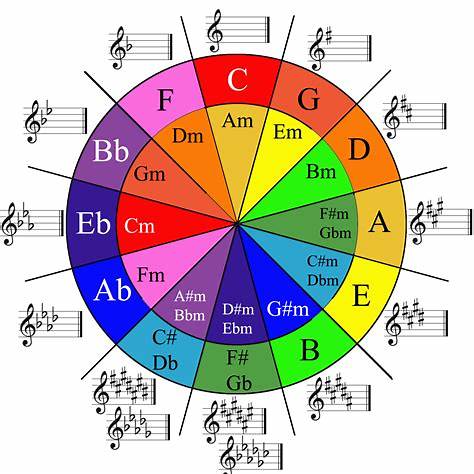Chord Transposer
Enter your song chords below. Use the arrow buttons to transpose up or down, or click "Clear" to reset. When ready, hit "Print" to print your transposed chords.
Learn About Chord Transposition
What is Chord Transposition?
Chord transposition is the process of changing the key of a song by shifting all its chords up or down by a consistent number of semitones. Transposing chords allows musicians to adjust songs to fit their vocal range or make them easier to play on a particular instrument.
How to Transpose Chords
- Optionally: Identify the original key of the song (e.g., C major). This can help you better understand the transposition process, but it’s not always necessary.
- Determine how many semitones you want to shift the key up or down.
- Use a chord transposition tool (like the one above!) to automatically find the new chords based on the transposition.
- Replace the old chords with the new transposed chords and play the song in the new key.
Chord Theory Basics
Understanding how chords are built and how they fit within a key is essential for transposing them correctly. Here's a more detailed de:
Major and Minor Chords
A major chord consists of three notes: the root, a major third, and a perfect fifth. For example, the C major chord contains the notes C, E, and G. In contrast, a minor chord consists of the root, a minor third, and a perfect fifth. The A minor chord, for example, contains A, C, and E.
Inversions
Chords can be inverted, meaning that the order of the notes changes, but the chord itself remains the same. In a C major chord, the notes are C-E-G, but in the first inversion, the notes are E-G-C, and in the second inversion, the notes are G-C-E.
Chords in a Key
In any major or minor key, there are seven chords that are naturally derived from the scale of that key. In C major, these chords are:
- C (I) - major
- D minor (ii) - minor
- E minor (iii) - minor
- F (IV) - major
- G (V) - major
- A minor (vi) - minor
- B diminished (vii°) - diminished
Example Song: Amazing Grace (Public Domain)
Here is an example of a well-known public domain song, “Amazing Grace.” Below are the original chords and the transposed chords after shifting up by 3 half steps.
Original Key (G major):
G C G D Amazing Grace, how sweet the sound, G C G D That saved a wretch like me. G C G D I once was lost, but now am found, G C G D Was blind, but now I see.
Transposed +3 Half Steps (B flat major):
Bb Eb Bb F Amazing Grace, how sweet the sound, Bb Eb Bb F That saved a wretch like me. Bb Eb Bb F I once was lost, but now am found, Bb Eb Bb F Was blind, but now I see.
Frequently Asked Questions
Do I need to know music theory to transpose chords?
No, using a tool like the one above makes it easy to transpose chords without needing in-depth music theory knowledge. However, understanding basic chord structure can help.
How do I transpose chords for piano?
To transpose chords for piano, simply use the tool above. It will show you the new chords based on the transposition. You can then play the transposed chords in the new key. Understanding piano chord inversions can help you smoothly transition between chords in different keys.
Is using a capo the same as transposing chords?
Using a capo is an alternative for guitarists who want to change the key without learning new chord shapes. However, it’s not a substitute for our tool. The tool helps you transpose the actual chords, which can be useful for learning new keys or when playing alongside other instruments like the piano.
Can I transpose any song?
Yes, most songs can be transposed. However, some songs may sound better in their original key due to the tonal quality of certain chords in that key.
Circle of Fifths
The Circle of Fifths is a foundational tool in music theory, illustrating the relationships between keys, scales, and chords. It’s essential for understanding harmony, modulation, and composition.

The Circle of Fifths: A visual guide to harmony.
How the Circle of Fifths Works
Outer Circle (Major Keys): The 12 major keys are arranged clockwise, starting with C major at the top. Moving clockwise, each key is a perfect fifth higher than the previous one.
Inner Circle (Relative Minor Keys): Each major key has a relative minor key, which shares the same key signature. These minor keys are displayed inside the circle, aligned with their corresponding major keys.
Sharps and Flats: Each key is accompanied by a small staff notation showing its sharps or flats. This helps visualize how key signatures evolve as you move around the circle:
- C major/A minor: No sharps or flats.
- G major/E minor: 1 sharp (F#).
- F major/D minor: 1 flat (Bb).
Practical Uses of the Circle of Fifths
Some of the many ways musicians use the Circle of Fifths:
- Key Signatures: Learn how many sharps or flats each key contains.
- Chord Progressions: Create natural-sounding progressions by following the circle.
- Modulation: Transition smoothly between keys by moving to adjacent ones.
- Understanding Harmony: Explore the relationships between major and minor keys.
Disclaimer: Provided "as is," this tool carries no warranties. The creators are not liable for any resulting impacts.
© 2024 chordtrans.com All rights reserved.